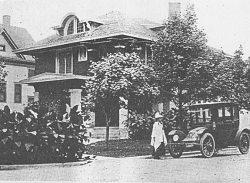
3 minute read
Otto’s Column
from Mt. Morris Times
by Shaw Media
LOCAL HISTORY
Fessler, Kauffman led Oregon suffrage movement
Editor’snote:OttoDick,Oregon hasresearchedthepeople,places andeventsimportantintheOregon area’shistory for theOgle CountyHistoricalSociety.Thefollowingisoneofa seriesofthearticleshehaswritten.
BY OTTO DICK
Du r i n g o u r e a r l y h i s t o r y women were denied some of the basic rights enjoyed by men.
F o r e xa mp l e m a rr ie d w om e n couldn’t own property, had no legal claim to any money they might earn and no female had the right to vote.
They were expected to do house work, raise a family and stay out of politics.
In Illinois women were not allowed to vote from 1818 to 1920 when the 19th Amendment was passed. “The right of citizens of the United States to vote shall not be denied or abridged by the States or by any State on account of sex.”
Other events in 1920 were the first commercial radio broadcast aired and the League of Nations was established.
When we vote today some people are not aware of the incredible fight women had to wage for the right to vote.
W o m en su f fr a g e i n t h e U n i t e d States was achieved gradually at state and local levels during the late 19th Century and early 20th Century, culminating with the Nineteenth Amendment to the United States Constitution.
Laura Fessler and Rebecca Kauffman led the movement for suffrage in the Oregon area.
Fessler, from Oregon, won a prize in 1914 for an essay “What Effect will Women’s Suffrage have on the human condition?”
Fessler was also responsible for securing the Iron Mike drinking fountain and Rebecca Kauffman was a leader in securing the White Pines State Park.
Another Oregon Resident Supreme Court Judge James Cartwright on March 5 clarified the legality of the Women’a Suffrage law. He said this was brought to the Supreme Court by Chicago Lawyers and that all laws are valid until it is shown that it is not constitutional.
He said that if the law was held u n c o n s t i t ut i o n a l b y t h e S u p re m e Court the votes of women would be kept separate to simplify the recount.
In Illinois an article in the Oregon Newspaper stated it appears that the constitutional amendment has made TOP: Rebecca Kauffman is shown here in a car as organizers try to get women the right to vote. FAR LEFT: Laura Fessler and her electric car. LEFT: Rebecca Kauffman

Photos supplied by Otto Dick
void the Illinois law which prohibits women from voting for constitutional offices, such as Justices of the Peace, Constables, Police Magistrates, Etc.
James L. McDowell State’s Attorney, Oregon, Illinois stated “Under amendment to the constitution of the United States women are entitled to vote at all elections same as male voters. Separate ballots, ballot boxes and poll books should be used for women.”
I guess they didn’t want to contaminate the male ballots with the women ballots. Later the newspaper reported the Nineteenth Amendment had done away with the two sets of ballots used for several years past in various elections in Illinois.
“(To Instruct Women Voters) The Oregon Equal Suffrage Association will hold an instruction voting for women on Friday and Saturday afternoons of this week from 2 to 5 o’clock, at the polling place in the basement of the northeast corner of th e c o u rt house.
Special ballots will be used and the voting carried out the same as on election day. Every woman in Oregon township interested in learning to mark her ballot correctly on April 7 is urged to attend these trial ballots. 1930 “Anna Farrell from Oregon will serve on April Juries. This total Suffrage movement must move on and maybe we will elect a woman for President.”

